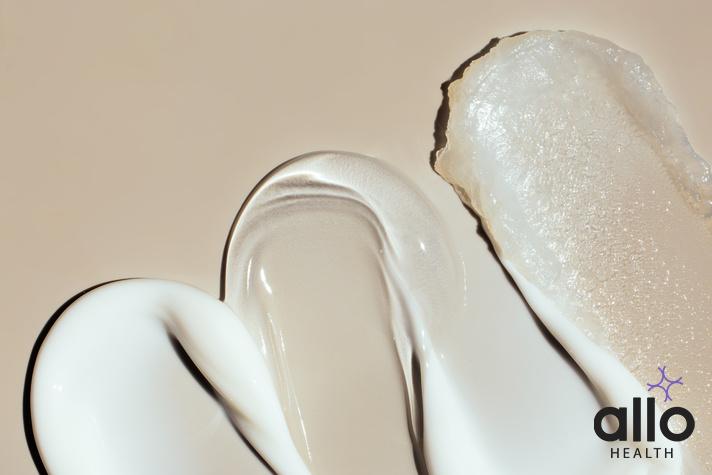Creaming During Sex: Natural Arousal Fluids

Allo Health is dedicated to personalized well-being, offering support and trusted information tailored to individual health goals. The platform emphasizes human-generated content, led by a distinguished medical team of experts, including physicians and sexual health specialists. Their commitment to credibility involves rigorous fact-checking, authoritative research, and continuous updates to ensure accurate, up-to-date information. Allo Health's unique approach goes beyond conventional platforms, providing expert-led insights and a continuous commitment to excellence, with user feedback playing a crucial role in shaping the platform's authoritative voice.

Dr. Aswathi P T earned her MBBS degree and completed her internship at Government Medical College, Kozhikode, and possess diverse professional background spanning 3.5 years. Her experience includes a wide range of healthcare settings, including health centers, hospitals, and teleconsultation services.
Why This Was Upated?
Our experts continually monitor the health and wellness space, and we update our articles when new information became available.
Updated on 25 June, 2024
- Article was updated as part of our commitment to diversity, equity, and inclusion.

"The following blog article provides general information and insights on various topics. However, it is important to note that the information presented is not intended as professional advice in any specific field or area. The content of this blog is for general educational and informational purposes only.
Book consultation
The content should not be interpreted as endorsement, recommendation, or guarantee of any product, service, or information mentioned. Readers are solely responsible for the decisions and actions they take based on the information provided in this blog. It is essential to exercise individual judgment, critical thinking, and personal responsibility when applying or implementing any information or suggestions discussed in the blog."
Creaming during sex is a natural and beautiful thing that can bring immense pleasure to both partners. If you’re curious about this phenomenon or are interested in experiencing it yourself, then read on. In this article, we’ll cover everything you need to know about creaming during sex: from what it is to how to achieve it and communicate about it with your partner.
Understanding What Creaming During Sex is?

- Creaming is a colloquial term used to describe the nature of vaginal discharge during sexual activities or so to say when you are “turned on”. The discharge serves as a way to lubricate the vagina, facilitating sexual activity and reducing friction. It can vary in consistency, color, and quantity depending on factors such as the menstrual cycle, hormonal changes, or individual differences.
- This is primarily produced by glands present in the cervix and vaginal regions. It is as normal as any other discharge from the body but only varies in its texture and color. it is generally thicker in consistency and has a white mucus-like texture to it than the normal discharge that’s often more transparent.
- You must be wondering how is the normal discharge you produce on a daily basis different from the one that is produced when you are sexually aroused or the discharge that is produced during masturbation. Basically, there are many types of discharges that a woman secretes during various stages. Sexual arousal typically calls for extra lubrication from the secretory glands than normal daily vaginal discharge that you might experience before/ during ovulation.
- This white discharge is often produced during orgasm and penetrative sex, but can also occur before after, or even during non-orgasmic sexual stimulation. White discharge is often considered a sign of healthy lubrication. Some women may experience creaming regularly, while others may never experience it. However, it is completely normal and healthy to produce this fluid during sex.
Difference between cervical fluid, the arousal fluid, and vaginal discharge:
it’s important to understand the difference between all these discharges as each serves a distinct function in female sexual health.
Cervical Fluid (Cervical Mucus):
- Purpose: Essential for fertility, changes consistency around ovulation.
- Appearance: Clear or egg-white-like, aids sperm movement.
Arousal Fluid (Vaginal Lubrication):
- Purpose: Lubricates during sexual arousal for comfort.
- Appearance: Clear or slightly milky, responds to arousal.
Vaginal Discharge:
- Composition: Mix of cervical and arousal fluids, plus vaginal cells and bacteria.
- Variation: Color, consistency, and amount vary; maintains vaginal health.
The Science Behind Creaming: How Arousal Affects Female Ejaculation
- Creaming is caused by the Skene’s gland being stimulated during sexual activity. During sexual arousal, there is an increase in blood pressure which increases blood flow to the vulva, which causes blood vessels around the vulva to swell up hence allowing fluid to pass through its wall. When a woman is sexually aroused, the Skene’s gland begins to produce fluid.
- This fluid then collects in the urethra and is released during orgasm. The amount of fluid produced during creaming varies from woman to woman; some may release a few drops, while others may release more substantial amounts.
- It is important to note that creaming is often confused with urine, as the fluid can come out of the urethra. However, it is believed that the fluid produced during creaming is different from urine and contains prostatic acid phosphatase (PAP), which is also found in male semen. This suggests that the Skene’s gland may have a similar function to the prostate gland in males.
- It is not a necessary component of sexual pleasure or satisfaction. However, for those who do experience it, it can be a pleasurable and exciting aspect of their sexual experiences.
What Does Vaginal Discharge During Sex Look Like?
Color:
- Clear or White: Normal discharge during sex can often appear clear or milky white, especially when a person is sexually aroused.
- Translucent or Slightly Yellowish: It might have a slight yellowish tint, particularly if mixed with semen or lubricants used during intercourse.
Texture and Consistency:
- Thin and Watery: During sexual arousal, the vaginal discharge tends to be more liquid and watery, serving as natural lubrication for easier penetration and movement.
- Thicker and Stretchy: Closer to ovulation, discharge might become more elastic or stretchy, similar to egg whites. This consistency aids in fertility and conception.
Amount:
- Varies Among Individuals: The amount of discharge during sex can differ from person to person and can range from barely noticeable to more substantial, depending on factors like arousal levels.
Odor:
- Typically Odorless: Normal vaginal discharge during sex usually doesn’t have a strong or unpleasant odor. A mild, musky scent might be noticeable, primarily due to increased vaginal secretions during arousal.
Is Creaming the Same as Squirting? The Differences Explained
Squirting is often confused with creaming. However, they are not the same thing. Squirting, also known as “female ejaculation,” is the release of a larger amount of fluid during orgasm, often with intense pressure. The fluid released during squirting comes from a different gland than the Skene’s gland, called the paraurethral gland. While squirting can be a pleasurable experience for some women, it should not be confused with creaming, which can occur without orgasm and is a more moderate release of fluid.
Creaming, also known as “squirting lite,” is the release of a smaller amount of white fluid during sexual arousal. This fluid comes from the Skene’s gland, which is located near the urethra. Unlike squirting, creaming does not always require orgasm and can happen during any stage of sexual activity. Some women may experience creaming as a natural lubricant during sex, while others may not produce any fluid at all.
Note that both squirting and creaming are normal bodily functions and should not be stigmatized or shamed.
How to Prepare for Creaming: Tips for Hygiene and Comfort

If you’re interested in experiencing creaming during sex, there are some things you can do to prepare.
- Firstly, make sure that you are well-hydrated, as this can help increase the amount of fluid produced.
- You may also want to trim your pubic hair, as it can make the area more comfortable and easier to access.
- Some women may also choose to insert a finger or sex toys like vibrator into the vagina before sex to help stimulate the Skene’s gland and increase fluid production.
- Using lubrication can help make sex more comfortable and increase the chances of creaming.
- One way to increase your chances of creaming is to focus on clitoral stimulation during sex. The clitoris is a primary erogenous zone for women and can help increase arousal and fluid production.
Know more about how to achieve maximum clitoral stimulation.
- Exploring different positions during sex, such as ones that allow for deeper penetration, can help stimulate the Skene’s gland and increase fluid production.
- It’s also important to practice good hygiene before and after sex, as the increased fluid production can create a moist environment that may increase the risk of infection.
- Make sure to wash your hands and genitals before and after sex, and consider using a pH-balanced wash to help maintain a healthy vaginal environment.
- If you experience any discomfort or unusual symptoms after creaming, such as itching or odor, it’s important to see a health care professional to rule out any infections or other underlying conditions.
Understanding Abnormal Vaginal Discharge: Causes and Concerns
Abnormal discharge can stem from various factors, indicating potential health conditions.
Some vaginal infections that cause abnormal vaginal discharge include:
- Yeast Infections: Overgrowth of yeast (Candida) in the vagina can lead to thick, white, cottage cheese-like discharge, accompanied by itching and irritation.
- Bacterial Infection (Vaginosis) (BV): An imbalance in vaginal bacteria often causes gray, white, or green discharge with a fishy odor.
- Sexually Transmitted Infections (STIs): Infections like trichomoniasis, chlamydia, or gonorrhea may cause changes in vaginal discharge along with itching, burning, or pain.
- Pelvic Inflammatory Disease (PID): An infection of the female reproductive organs can cause abnormal discharge, pelvic pain, fever, and discomfort during intercourse.
- Allergic Reactions or Irritation: Certain products like condoms, spermicides, soaps, or materials might lead to irritation, resulting in abnormal discharge.
Warning Signs to Watch for:
- Color Changes: Yellow, green, gray, or yellow discharge instead of the usual clear or white.
- Texture Differences: Discharge becoming thicker, clumpy, or having an unusual clumpy or cottage cheese-type texture.
- Increased Amount: A sudden increase in the volume of discharge.
- Unpleasant Odor: Foul-smelling discharge, often described as a fishy smell or strong.
- Accompanying Symptoms: Itching, burning, redness, swelling, vaginal bleeding, painful urination or sex, pelvic pain, or any discomfort in the vaginal area might indicate bacterial fungal or yeast infections or any other underlying issue that requires medical attention.
Treatment for Abnormal Creaming:
The treatment of abnormal vaginal discharge depends upon the causative agents. Though most microbial-caused abnormal discharges can be treated using broad-spectrum antibiotics, and antifungal creams that can be accessed as over-the-counter drugs, it is still important to seek consultancy from a healthcare provider to rule out the risk of sexually transmitted infections, for proper treatment of abnormal creaming.
How to Overcome Embarrassment or Shame About Creaming

It’s common for women to feel embarrassed or ashamed about creaming during sex. However, it’s important to remember that it’s a natural and healthy part of sexual arousal and pleasure. If you feel uncomfortable discussing the topic with your partner, try talking to a trusted friend or therapist. Remember, everyone’s sexual experiences are valid and normal, and there’s no shame in enjoying creaming during sex. Here are some tips to help you overcome your shame:
- Learn from Reliable Sources: Educate yourself about vaginal health from trusted medical resources or healthcare providers.
- Mindset Shift: Reframe your perspective by acknowledging that vaginal discharge is a normal and healthy bodily function.
- Self-Exploration: Explore and understand your body’s natural responses to sexual arousal.
- Positive Reinforcement: Focus on the pleasure and intimacy of the sexual experience rather than fixating on bodily functions.
- Empowerment Through Knowledge: Being informed about your body’s functions can empower you to feel more confident and comfortable.
- Support Networks: Seek support from friends or online communities where discussing sexual health is normalized and encouraged.
- Patience and Compassion: Be patient with yourself and practice self-compassion, recognizing that everyone’s body experiences variations.
Debunking the Myths Surrounding Creaming During Sex
There are many myths surrounding creaming during sex, which can often lead to confusion and misunderstanding.
- Myth: Creaming indicates an STI or infection.
Fact: Increased vaginal lubrication during sex is a normal physiological response to arousal. While changes in discharge might occur due to infections, not all creaming or increased lubrication signals an infection.
- Myth: Creaming means a lack of hygiene.
Fact: Vaginal lubrication during sex is a natural process and not an indicator of poor hygiene. Regular hygiene practices are important, but natural vaginal lubrication is a separate bodily function.
- Myth: Creaming always means a woman is ready for sex.
Fact: Vaginal lubrication might not always correspond to readiness for intercourse. Communication and mutual consent are essential for a comfortable and enjoyable sexual experience.
- Myth: Creaming is a problem that needs to be stopped.
Fact: Natural vaginal lubrication is a healthy response that helps reduce discomfort and friction during sex. Unless it causes discomfort or is excessive due to an underlying issue, it’s generally not a problem that requires stopping.
- Myth: Creaming leads to infertility or difficulties in conceiving.
Fact: Natural vaginal lubrication during sex does not hinder fertility. In fact, it can aid in conception by providing a conducive environment for sperm movement.
Conclusion
It’s important to understand that creaming is normal and functions well in lubrication during arousal. There isn’t any specific amount of this white discharge that is considered normal and it really varies from person to person. It varies in texture, quantity, and color, often enhancing pleasure. Understanding the differences in vaginal discharges and embracing the natural fluid variations is essential.
Communicating with your partner about preferences, practicing good hygiene, and seeking medical advice for abnormal discharges contribute to a healthy sexual experience. Remember, experiencing creaming or squirting is normal and should be destigmatized, fostering a positive and open attitude toward sexual exploration and pleasure.
Frequently Asked Questions (FAQs)
Q. What is considered normal vaginal discharge during sex?
Answer: Normal vaginal discharge during sex varies in consistency, usually appearing as clear or slightly milky fluid. It serves as natural lubrication for comfortable intercourse.
Q: Is increased vaginal discharge or “creaming” during sex a cause for concern?
Answer: In most cases, increased discharge during sex is a natural response to arousal. However, significant changes in color, odor, or accompanied by discomfort should be evaluated by a healthcare professional.
Q. Can vaginal discharge during sex affect fertility or conception?
Answer: Typically, vaginal discharge during sex aids in lubrication and is unrelated to fertility issues. However, if an underlying condition affects fertility, consult a healthcare provider.
Q. How can one differentiate between normal arousal fluid and a potential infection related to vaginal discharge during sex?
Answer: Normal arousal fluid is usually clear or slightly milky and is odorless. Any changes in color, odor, or accompanying symptoms like itching or pain might indicate an infection that needs medical attention.
Q. Are there ways to manage excessive vaginal discharge or discomfort during sex?
Answer: Using additional lubricants, maintaining good personal hygiene, and communicating openly with your partner about comfort levels can help manage excessive discharge or discomfort during sexual activity. However, if it causes persistent discomfort, consult a healthcare professional






































